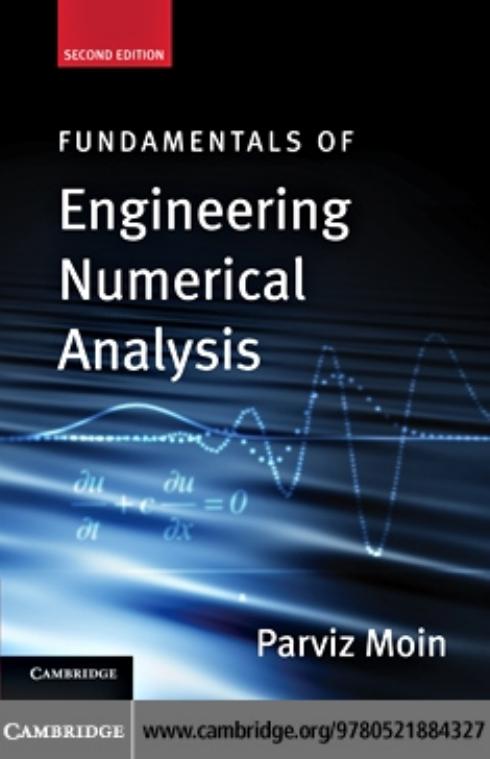Fundamentals of Engineering Numerical Analysis 2nd Edition by Parviz Moin ISBN 0511922213 9780511922213
$70.00 Original price was: $70.00.$35.00Current price is: $35.00.
Instant download Fundamentals of Engineering Numerical Analysis 2nd Edition after payment
Fundamentals of Engineering Numerical Analysis 2nd Edition by Parviz Moin – Ebook PDF Instant Download/Delivery: 0511922213, 9780511922213
Full download Fundamentals of Engineering Numerical Analysis 2nd edition after payment

Product details:
ISBN 10: 0511922213
ISBN 13: 9780511922213
Author: Parviz Moin
Since the original publication of this book, available computer power has increased greatly. Today, scientific computing is playing an ever more prominent role as a tool in scientific discovery and engineering analysis. In this second edition, the key addition is an introduction to the finite element method. This is a widely used technique for solving partial differential equations (PDEs) in complex domains. This text introduces numerical methods and shows how to develop, analyse, and use them. Complete MATLAB programs for all the worked examples are now available at www.cambridge.org/Moin, and more than 30 exercises have been added. This thorough and practical book is intended as a first course in numerical analysis, primarily for new graduate students in engineering and physical science. Along with mastering the fundamentals of numerical methods, students will learn to write their own computer programs using standard numerical methods.
Fundamentals of Engineering Numerical Analysis 2nd Table of contents:
1 Interpolation
1.1 Lagrange Polynomial Interpolation
1.2 Cubic Spline Interpolation
EXERCISES
FURTHER READING
2 Numerical Differentiation – Finite Differences
2.1 Construction of Difference Formulas Using Taylor Series
2.2 A General Technique for Construction of Finite Difference Schemes
2.3 An Alternative Measure for the Accuracy of Finite Differences
2.4 Padé Approximations
2.5 Non-Uniform Grids
EXERCISES
FURTHER READING
3 Numerical Integration
3.1 Trapezoidal and Simpsons Rules
3.2 Error Analysis
3.3 Trapezoidal Rule with End-Correction
3.4 Romberg Integration and Richardson Extrapolation
3.5 Adaptive Quadrature
3.6 Gauss Quadrature
EXERCISES
FURTHER READING
4 Numerical Solution of Ordinary Differential Equations
4.1 Initial Value Problems
4.2 Numerical Stability
4.3 Stability Analysis for the Euler Method
4.4 Implicit or Backward Euler
4.5 Numerical Accuracy Revisited
4.6 Trapezoidal Method
4.7 Linearization for Implicit Methods
4.8 Runge–Kutta Methods
4.9 Multi-Step Methods
4.10 System of First-Order Ordinary Differential Equations
4.11 Boundary Value Problems
4.11.1 Shooting Method
4.11.2 Direct Methods
EXERCISES
FURTHER READING
5 Numerical Solution of Partial Differential Equations
5.1 Semi-Discretization
5.2 von Neumann Stability Analysis
5.3 Modified Wavenumber Analysis
5.4 Implicit Time Advancement
5.5 Accuracy via Modified Equation
5.6 Du Fort–Frankel Method: An Inconsistent Scheme
5.7 Multi-Dimensions
5.8 Implicit Methods in Higher Dimensions
5.9 Approximate Factorization
5.9.1 Stability of the Factored Scheme
5.9.2 Alternating Direction Implicit Methods
5.9.3 Mixed and Fractional Step Methods
5.10 Elliptic Partial Differential Equations
5.10.1 Iterative Solution Methods
5.10.2 The Point Jacobi Method
5.10.3 Gauss–Seidel Method
5.10.4 Successive Over Relaxation Scheme
5.10.5 Multigrid Acceleration
EXERCISES
FURTHER READING
6 Discrete Transform Methods
6.1 Fourier Series
6.1.1 Discrete Fourier Series
6.1.2 Fast Fourier Transform
6.1.3 Fourier Transform of a Real Function
6.1.4 Discrete Fourier Series in Higher Dimensions
6.1.5 Discrete Fourier Transform of a Product of Two Functions
6.1.6 Discrete Sine and Cosine Transforms
6.2 Applications of Discrete Fourier Series
6.2.1 Direct Solution of Finite Differenced Elliptic Equations
6.2.2 Differentiation of a Periodic Function Using Fourier Spectral Method
6.2.3 Numerical Solution of Linear, Constant Coefficient Differential Equations with Periodic Bounda
6.3 Matrix Operator for Fourier Spectral Numerical Differentiation
6.4 Discrete Chebyshev Transform and Applications
6.4.1 Numerical Differentiation Using Chebyshev Polynomials
6.4.2 Quadrature Using Chebyshev Polynomials
6.4.3 Matrix Form of Chebyshev Collocation Derivative
6.5 Method of Weighted Residuals
6.6 The Finite Element Method
6.6.1 Application of the Finite Element Method to a Boundary Value Problem
6.6.2 Comparison with Finite Difference Method
6.6.3 Comparison with a Padé Scheme
6.6.4 A Time-Dependent Problem
The One-Dimensional Heat Equation
6.7 Application to Complex Domains
6.7.1 Constructing the Basis Functions
EXERCISES
FURTHER READING
APPENDIX A Review of Linear Algebra
A.1 Vectors, Matrices and Elementary Operations
A.2 System of Linear Algebraic Equations
A.2.1 Effects of Round-off Error
A.3 Operations Counts
A.4 Eigenvalues and Eigenvectors
Index
People also search Fundamentals of Engineering Numerical Analysis 2nd :
fundamentals of engineering numerical analysis solution manual pdf
fundamentals of engineering numerical analysis
fundamentals of engineering design 2nd edition pdf
numerical analysis 2nd edition pdf
engineering fundamentals and problem solving 7th edition free
Tags: Parviz Moin, Engineering Numerical, Fundamentals


